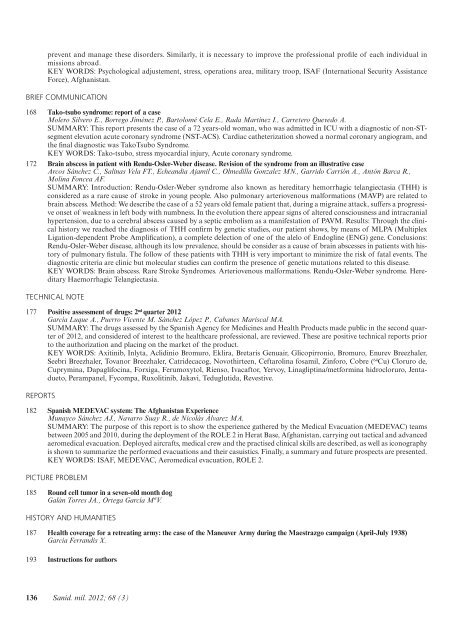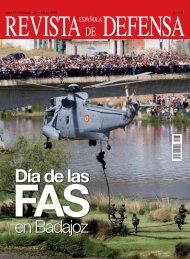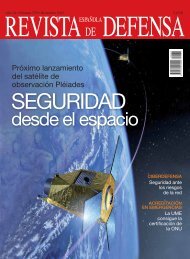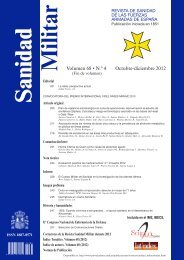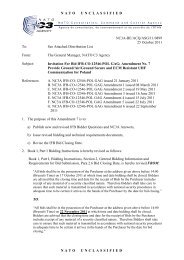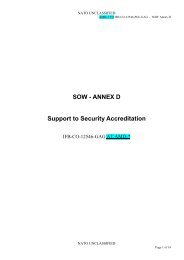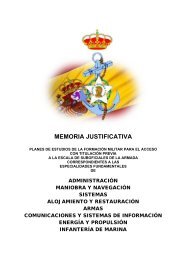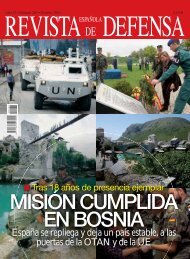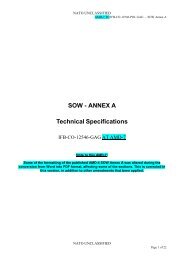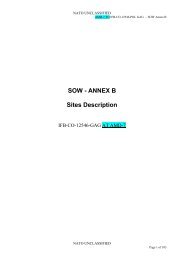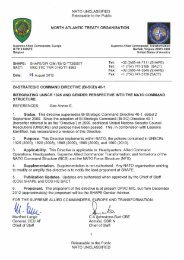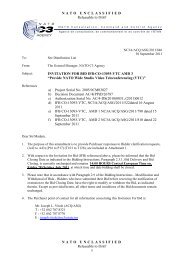Sanidad MilitarRevista <strong>de</strong> Sanidad <strong>de</strong> las Fuerzas Armadas <strong>de</strong> EspañaSanid. Mil. <strong>Volumen</strong> <strong>68</strong>, número 3. ISSN: 1887-8571 <strong>Julio</strong>-Septiembre <strong>2012</strong>137 Presentation of IGESANHernán<strong>de</strong>z Ferrero L.EDITORIAL138 Feeding in area of operations and cardiovascular riskLisbona Gil A., Rosado Sierra JA.AWARD OF THE PRIZE FIDEL PAGÉS MIRAVÉ <strong>2012</strong>CONTENTSORIGINAL ARTICLE141 PRIZE FIDEL PAGES MIRAVÉ <strong>2012</strong>Kill the Killers: Natural Killer cells therapy against paediatric refractory solid tumoursValentín Quiroga J., Fernán<strong>de</strong>z Casanova L., Génesis Martín I., Nuñez Martín F., Pérez Martínez A.SUMMARY: Introduction: Refractory solid tumours lead children <strong>de</strong>aths. To change this statement, new treatments shouldbe <strong>de</strong>veloped. Natural Killer cells constitute the first line of <strong>de</strong>fence against tumour cells. We propose a new strategy for antitumorcell therapy in children with refractory solid malignancies: IL-15 stimulated NK cells. Patients and methods: 22 paediatricpatients suffering refractory solid tumours participate in this study. We compare NK cell subsets and K562 cytotoxicityin patients and sex-age pair’s healthy controls. We use multiparametric flow and time-resolved fluorescent, respectively. In immunocompromisedmice we <strong>de</strong>veloped an aggressive human metastatic neuroblastoma mo<strong>de</strong>l and IL-15 stimulated NK cellsrescue. Results: Patients had higher NK bright cells subset and lower NK cytotoxicity than healthy controls. IL-15 stimulatedNK cells improved NK cell cytotoxicity in vitro and <strong>de</strong>creased tumour bur<strong>de</strong>n in vivo. Conclusions: IL-15 stimulated NK cellsmay constitute a new cell therapy tool for paediatric refractory tumours.KEY WORDS: Natural Killer cells (NK), interleucina 15 (IL-15), refractory solid tumours.147 SPECIAL MENTION PRIZE FIDEL PAGES MIRAVÉ <strong>2012</strong>Conditions of drugs transportation in international missions of the Armed Forces. Design of a specific stability study of operationsZamanillo Sainz A., Verón Moros M., Juberías Sánchez A., Cabrera Merino JI., Mañes Pradas JP.157 Clinical findings during high g forces exposure in human centrifugeAlonso Rodríguez C., Medina Font J., Puente Espada B.SUMMARY: Introduction: The man exposure to high acceleration level produces the appearance of signs and symptoms,including the risk of loss of consciousness, that may compromise flight safety, and the training in human centrifuge is anuseful method to improve the high acceleration tolerance. Material and methods: We assessed the appearance of symptomsand signs in a group of 81 fighter pilots who un<strong>de</strong>rwent advanced human centrifuge training, by exposing themselves to a 7Gz for 15 seconds, with an on-set rate of 6 G/ second. We also studied the individual relaxed G tolerance level. Results: Visualsymptoms were reported by 96,3% (greyout 88,9%, tunnel vision 72,9%, blackout 39,5%). We found that 90,1% presentedpetechials hemorrhages, 88,6% reported fatigue and 75,8% disorientation or vertigo. Musculoskeletal pain was commonlyreported affecting to different body parts: to forearms in 60,5%, to the thighs in 58%, to the arms in 40,7%, to the neck in30,9%, to the abdomen in 23,5%, to the chest in 20,5% and to the elbows in 20,3% of the pilots. The average relaxed G-leveltolerance was established in 4,79 ± 0,81 Gz, with a range between 3,40 Gz and 6,86 Gz, by using a centrifuge gradual on-setrate. Conclusions: Comparing the G level tolerance with the symptoms and signs, we found a significant greater prevalence ofblackout among pilots with the biggest and the least tolerance than among those pilots with intermediate tolerance. We havenot found any differences between the G level tolerance and the prevalence of petechiae, weariness, vertigo or musculoskeletalaches of different locations.KEY WORDS: Accelerations, Grey out, Blackout, Petechiae, Fatigue, Disorientation, Loss of consciousness, Human centrifuge.163 A <strong>de</strong>scriptive analysis of the Spanish military personnel atten<strong>de</strong>d by the Psychology Service at ROLE 2, Herat, AfghanistanMartínez Sánchez JA.SUMMARY: Introduction: Since 2005, the Service of Psychology of ROLE 2 of the Forward Support Base, Herat(Afghanistan), provi<strong>de</strong>s psychological assistance to the Spanish military personnel <strong>de</strong>ployed in this Afghan province.This assistance takes a large value for the welfare of our troops, given the nature of risk and danger of the missions inAfghanistan. Methods: Observational, <strong>de</strong>scriptive, transversal of military people assisted by the Service of PsychologyROLE 2 between May 2005 and September 2009. Results: The total number of cases analyzed was 172. Anxiety disor<strong>de</strong>rsand adjustment disor<strong>de</strong>rs were the diagnostic categories the more frequently assigned, being the most commontherapeutic approach to control anxiety, cognitive therapy and repatriation or return to Spain. Conclusion: Trainingand educational programs are necessary to promote the adaptation of our troops in operations area in or<strong>de</strong>r to i<strong>de</strong>ntify,Sanid. mil. <strong>2012</strong>; <strong>68</strong> (3) 135
prevent and manage these disor<strong>de</strong>rs. Similarly, it is necessary to improve the professional profile of each individual inmissions abroad.KEY WORDS: Psychological adjustement, stress, operations area, military troop, ISAF (International Security AssistanceForce), Afghanistan.BRIEF COMMUNICATION1<strong>68</strong> Tako-tsubo syndrome: report of a caseMolero Silvero E., Borrego Jiménez P., Bartolomé Cela E., Rada Martínez I., Carretero Quevedo A.SUMMARY: This report presents the case of a 72 years-old woman, who was admitted in ICU with a diagnostic of non-STsegmentelevation acute coronary syndrome (NST-ACS). Cardiac catheterization showed a normal coronary angiogram, andthe final diagnostic was TakoTsubo Syndrome.KEY WORDS: Tako-tsubo, stress myocardial injury, Acute coronary syndrome.172 Brain abscess in patient with Rendu-Osler-Weber disease. Revision of the syndrome from an illustrative caseArcos Sánchez C., Salinas Vela FT., Echeandia Ajamil C., Olmedilla Gonzalez MN., Garrido Carrión A., Antón Barca R.,Molina Foncea AF.SUMMARY: Introduction: Rendu-Osler-Weber syndrome also known as hereditary hemorrhagic telangiectasia (THH) isconsi<strong>de</strong>red as a rare cause of stroke in young people. Also pulmonary arteriovenous malformations (MAVP) are related tobrain abscess. Method: We <strong>de</strong>scribe the case of a 52 years old female patient that, during a migraine attack, suffers a progressiveonset of weakness in left body with numbness. In the evolution there appear signs of altered consciousness and intracranialhypertension, due to a cerebral abscess caused by a septic embolism as a manifestation of PAVM. Results: Through the clinicalhistory we reached the diagnosis of THH confirm by genetic studies, our patient shows, by means of MLPA (MultiplexLigation-<strong>de</strong>pen<strong>de</strong>nt Probe Amplification), a complete <strong>de</strong>lection of one of the alelo of Endogline (ENG) gene. Conclusions:Rendu-Osler-Weber disease, although its low prevalence, should be consi<strong>de</strong>r as a cause of brain abscesses in patients with historyof pulmonary fistula. The follow of these patients with THH is very important to minimize the risk of fatal events. Thediagnostic criteria are clinic but molecular studies can confirm the presence of genetic mutations related to this disease.KEY WORDS: Brain abscess. Rare Stroke Syndromes. Arteriovenous malformations. Rendu-Osler-Weber syndrome. HereditaryHaemorrhagic Telangiectasia.TECHNICAL NOTE177 Positive assessment of drugs: 2 nd quarter <strong>2012</strong>García Luque A., Puerro Vicente M. Sánchez López P., Cabanes Mariscal MA.SUMMARY: The drugs assessed by the Spanish Agency for Medicines and Health Products ma<strong>de</strong> public in the second quarterof <strong>2012</strong>, and consi<strong>de</strong>red of interest to the healthcare professional, are reviewed. These are positive technical reports priorto the authorization and placing on the market of the product.KEY WORDS: Axitinib, Inlyta, Aclidinio Bromuro, Eklira, Bretaris Genuair, Glicopirronio, Bromuro, Enurev Breezhaler,Seebri Breezhaler, Tovanor Breezhaler, Catri<strong>de</strong>cacog, Novothirteen, Ceftarolina fosamil, Zinforo, Cobre ( 64 Cu) Cloruro <strong>de</strong>,Cuprymina, Dapaglifocina, Forxiga, Ferumoxytol, Rienso, Ivacaftor, Yervoy, Linagliptina/metformina hidrocloruro, Jentadueto,Perampanel, Fycompa, Ruxolitinib, Jakavi, Teduglutida, Revestive.REPORTS182 Spanish MEDEVAC system: The Afghanistan ExperienceMunayco Sánchez AJ., Navarro Suay R., <strong>de</strong> Nicolás Álvarez MA.SUMMARY: The purpose of this report is to show the experience gathered by the Medical Evacuation (MEDEVAC) teamsbetween 2005 and 2010, during the <strong>de</strong>ployment of the ROLE 2 in Herat Base, Afghanistan, carrying out tactical and advancedaeromedical evacuation. Deployed aircrafts, medical crew and the practised clinical skills are <strong>de</strong>scribed, as well as iconographyis shown to summarize the performed evacuations and their casuistics. Finally, a summary and future prospects are presented.KEY WORDS: ISAF, MEDEVAC, Aeromedical evacuation, ROLE 2.PICTURE PROBLEM185 Round cell tumor in a seven-old month dogGalán Torres JA., Ortega García MªV.HISTORY AND HUMANITIES187 Health coverage for a retreating army: the case of the Maneuver Army during the Maestrazgo campaign (April-July 1938)García Ferrandis X.193 Instructions for authors136 Sanid. mil. <strong>2012</strong>; <strong>68</strong> (3)
- Page 1: SanidadISSN 1887-8571MilitarEditori
- Page 6 and 7: Presentación del IGESANEn este pri
- Page 8 and 9: Editorialponesa y la mediterránea.
- Page 10 and 11: ARTÍCULO ORIGINALPREMIO FIDEL PAG
- Page 12 and 13: Kill the killers; terapia con célu
- Page 14 and 15: Kill the killers; terapia con célu
- Page 16 and 17: ARTÍCULO ORIGINALACCESIT DEL PREMI
- Page 18 and 19: Condiciones de transporte de medica
- Page 20 and 21: Condiciones de transporte de medica
- Page 22: Condiciones de transporte de medica
- Page 25 and 26: A. Zamanillo Sainz, et al.límites
- Page 27 and 28: C. Alonso Rodríguez, et al.lo larg
- Page 29 and 30: C. Alonso Rodríguez, et al.Desorie
- Page 31 and 32: C. Alonso Rodríguez, et al.toleran
- Page 33 and 34: J. A. Martínez Sánchezla FSB disp
- Page 35 and 36: J. A. Martínez SánchezTabla 6. Es
- Page 37 and 38: COMUNICACIÓN BREVESíndrome de Tak
- Page 39 and 40: E. Molero Silvero, et al.La mayorí
- Page 41 and 42: COMUNICACIÓN BREVEAbsceso cerebral
- Page 43 and 44: C. Arcos Sánchez, et al.Figura 3:
- Page 45 and 46: C. Arcos Sánchez, et al.A pesar de
- Page 47 and 48: A. García Luque, et al.La indicaci
- Page 49 and 50: A. García Luque, et al.con crisis
- Page 51 and 52: INFORMESModelo español de MEDEVAC.
- Page 53 and 54: A. J. Munayco Sánchez, et al.Mucho
- Page 55 and 56:
IMAGEN PROBLEMADiagnóstico: Histio
- Page 57 and 58:
X. García FerrandisAranda y Varela
- Page 59 and 60:
X. García FerrandisFigura 3. Ficha
- Page 61 and 62:
X. García Ferrandisamplio. Esta in
- Page 63:
AGRADECIMIENTOSEscriba los agradeci


